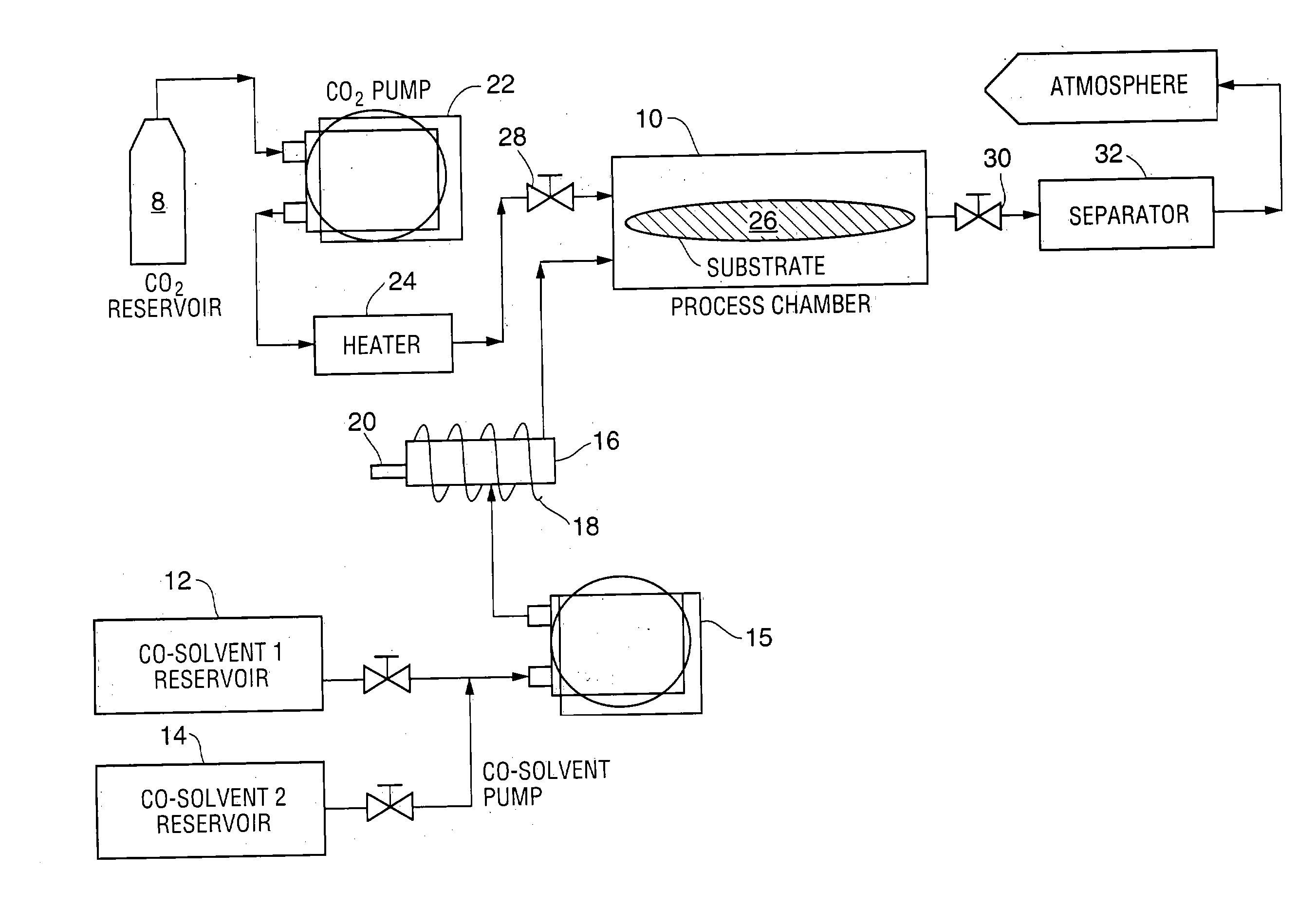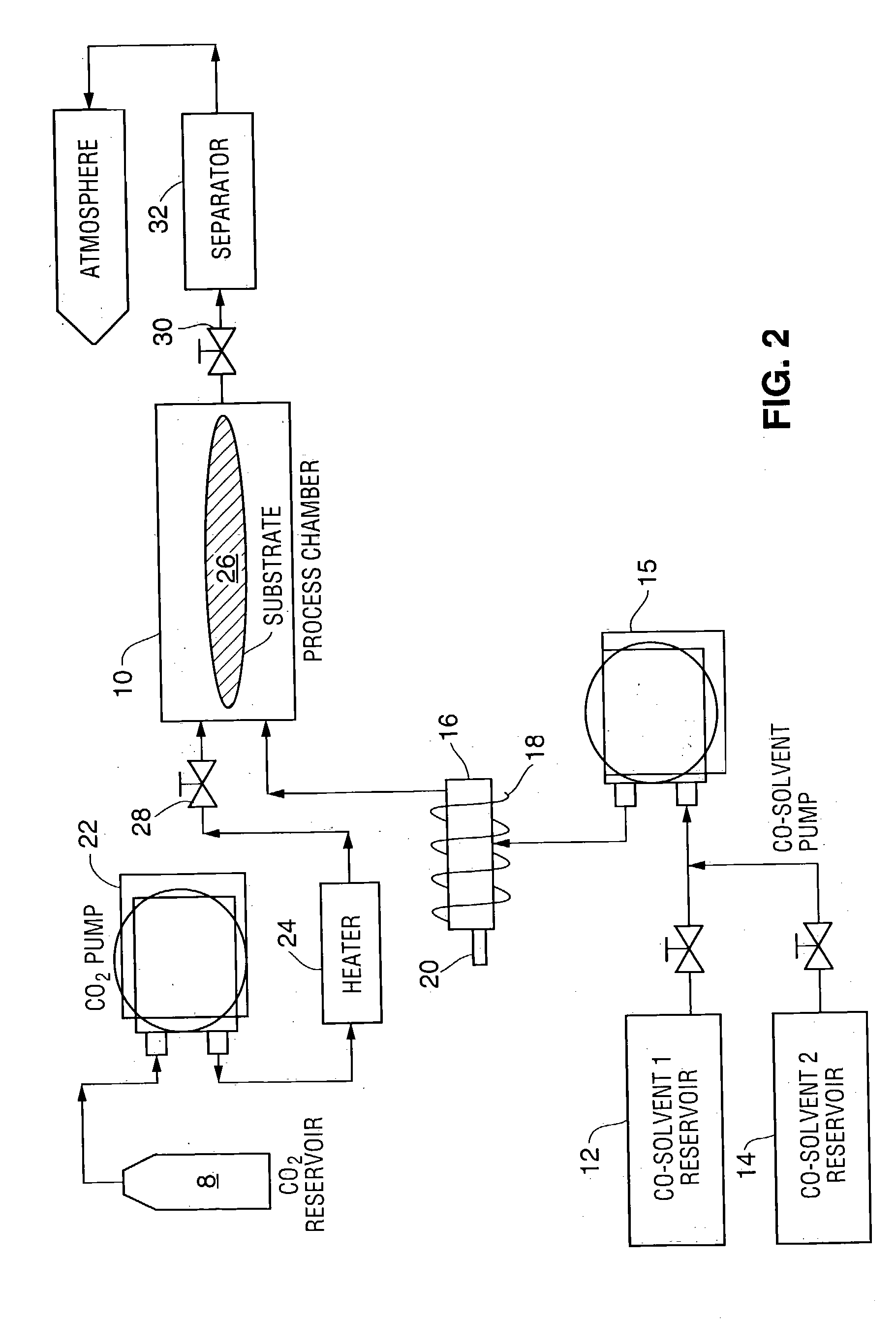Compositions and method for removing photoresist and/or resist residue at pressures ranging from ambient to supercritical
a technology of photoresist and supercritical, applied in the direction of photomechanical equipment, instruments, liquid cleaning, etc., can solve the problems of large geometries becoming "killer" defects of devices with sub-micron critical dimensions, surface states and charges, and the residue of plasma etching process, etc., to accelerate photoresist stripping, accelerate photoresist stripping, and increase the reaction kinetics and mass transport of reactant and product species
- Summary
- Abstract
- Description
- Claims
- Application Information
AI Technical Summary
Benefits of technology
Problems solved by technology
Method used
Image
Examples
example 1
[0074] In a first example, a substrate having a hard baked I-line photoresist that was DUV stabilized using UV lamps to achieve 100% cross-linking was placed in the process chamber. A co-solvent 1 composition of 40% (by weight) 1,2-Butylene Carbonate, 30% Dimethyl Sulfoxide, and 30% of 30% hydrogen peroxide was mixed at a temperature of 55.degree. C.
[0075] The 1,2-Butylene Carbonate was selected for its high solvency and the fact that it makes a single-phase solution with hydrogen peroxide. Ethylene or Propylene Carbonate or blends of Ethylene and Propylene Carbonate may be substituted for the 1,2-Butylene Carbonate (and vice versa) in this and the following examples. The hydrogen peroxide was selected for its ability to attack the cross-linked bonds of the photoresist, and the dimethyl sulfoxide was selected for its ability to carry out photoresist stripping. This mixture was made to flow into the process chamber and onto the substrate at a rate of 8 g / min for approximately 90 seco...
example 2
[0078] In the second example, the co-solvent mix was unchanged but was introduced into the process chamber in higher amounts at the start of the run. The complete process was run without any static dwell in the process chamber. A substrate having a hard baked I-line photoresist that was DUV stabilized using UV lamps to achieve 100% cross-linking was placed in the process chamber. A co-solvent 1 composition of 40% (by weight) 1,2-Butylene Carbonate, 30% Dimethyl Sulfoxide, and 30% of 30% hydrogen peroxide was mixed at a temperature of 50.degree. C. This mixture was made to flow into the process chamber and onto the substrate at a rate of 20 g / min for approximately 30 seconds. Supercritical carbon dioxide was caused to flow into the chamber with the co-solvent 1 at a flow rate of 60 g / min to have a total fluid flow rate into the process chamber at 80 g / min. Subsequently the co-solvent 1 flow rate was decreased to 2.4 g / min and the supercritical carbon dioxide flow rate increased to 77...
example 3
[0081] The third example is similar to Example 2, but differs in that a different co-solvent 1 composition was used. A substrate having a hard baked I-line photoresist that was DUV stabilized using UV lamps to achieve 100% cross-linking was placed in the process chamber. A co-solvent 1 composition of 40% (by weight) 1,2-Butylene Carbonate, 40% Benzyl Alcohol, and 20% of 30% hydrogen peroxide was mixed at a temperature of 50.degree. C. This mixture was made to flow into the process chamber and onto the substrate at a rate of 20 g / min for approximately 45 seconds. Supercritical carbon dioxide was caused to flow into the chamber with the co-solvent 1 at a flow rate of 60 g / min to have a total fluid flow rate into the process chamber at 80 g / min. Subsequently the co-solvent 1 flow rate was decreased to 2.4 g / min and the supercritical carbon dioxide flow rate increased to 77.6 g / min. for the next 3 minutes and 15 seconds. The operating temperature and pressure within the chamber were 110...
PUM
| Property | Measurement | Unit |
|---|---|---|
| critical pressure | aaaaa | aaaaa |
| critical temperature | aaaaa | aaaaa |
| temperatures | aaaaa | aaaaa |
Abstract
Description
Claims
Application Information
 Login to View More
Login to View More - R&D
- Intellectual Property
- Life Sciences
- Materials
- Tech Scout
- Unparalleled Data Quality
- Higher Quality Content
- 60% Fewer Hallucinations
Browse by: Latest US Patents, China's latest patents, Technical Efficacy Thesaurus, Application Domain, Technology Topic, Popular Technical Reports.
© 2025 PatSnap. All rights reserved.Legal|Privacy policy|Modern Slavery Act Transparency Statement|Sitemap|About US| Contact US: help@patsnap.com



